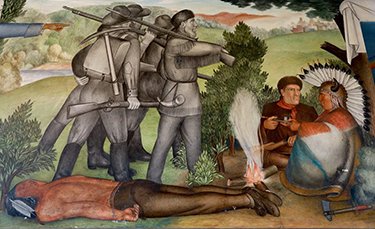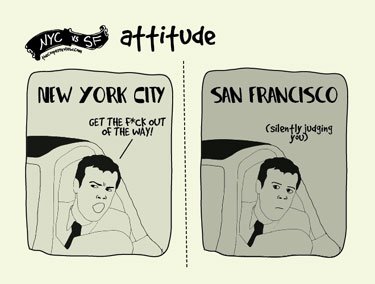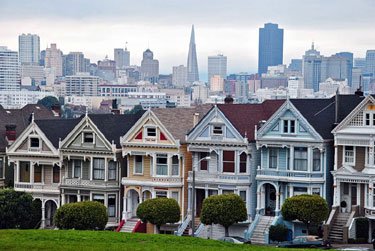Category Archive 'San Francisco'
03 Dec 2019


Wes Enzinna, in Harper’s, describes the bizarre fringe existence of a millennial bourgeois Bohemian trying to find living space in ever-so-rich, ever-so-f*cked-up Bay Area California.
[T]he year of the Ghost Ship fire, I lived in a shack. I’d found the place just as September’s Indian summer was giving way to a wet October. There was no plumbing or running water to wash my hands or brush my teeth before sleep. Electricity came from an extension cord that snaked through a yard of coyote mint and monkey flower and up into a hole I’d drilled in my floorboards. The structure was smaller than a cell at San Quentin—a tiny house or a huge coffin, depending on how you looked at it—four by eight and ten feet tall, so cramped it fit little but a mattress, my suit jackets and ties, a space heater, some novels, and the mason jar I peed in.
The exterior of my hermitage was washed the color of runny egg yolk. Two redwood French doors with plexiglass windows hung cockeyed from creaky hinges at the entrance, and a combination lock provided meager security against intruders. White beadboard capped the roof, its brim shading a front porch set on cinder blocks.
After living on the East Coast for eight years, I’d recently left New York City to take a job at an investigative reporting magazine in San Francisco. If it seems odd that I was a fully employed editor who lived in a thirty-two-square-foot shack, that’s precisely the point: my situation was evidence of how distorted the Bay Area housing market had become, the brutality inflicted upon the poor now trickling up to everyone but the super-rich. The problem was nationwide, although, as Californians tend to do, they’d taken this trend to an extreme. Across the state, a quarter of all apartment dwellers spent half of their incomes on rent. Nearly half of the country’s unsheltered homeless population lived in California, even while the state had the highest concentration of billionaires in the nation. In the Bay Area, including West Oakland, where my shack was located, the crisis was most acute. Tent cities had sprung up along the sidewalks, swarming with capitalism’s refugees. Telegraph, Mission, Market, Grant: every bridge and overpass had become someone’s roof.
Down these same streets, tourists scuttered along on Segways and techies surfed the hills on motorized longboards, transformed by their wealth into children, just as the sidewalk kids in cardboard boxes on Haight or in People’s Park aged overnight into decrepit adults, the former racing toward the future, the latter drifting away from it.
To my mother and girlfriend back East, the “shack situation†was a problem to be solved. “Can we help you find another place?†“Can you just find roommates and live in a house?†But the shack was the solution, not the problem.
As penance for abandoning my girlfriend, I still paid part of our rent in New York, and after covering my portion of our bills, my student loan payment, and car insurance, I had about $1,500 left over each month. That wouldn’t have been so little to live on, except that, according to some estimates, apartments then averaged $3,500 a month in San Francisco, $3,000 in Oakland. That year, 2016, 83,733 low-income San Franciscans would apply for the city’s affordable housing lottery, fighting for 1,025 slots. There were still cheap rooms available in the Bay, to be sure, mostly in ramshackle Victorians or weathered Maybeck bungalows where artists or activists or punks lived collectively and were protected by rent control, but these rooms were in dwindling supply and astonishingly high demand. On Craigslist or by word of mouth, vacancies were often offered exclusively to “Q.T.P.O.C.†(queer and trans people of color) or “B.A.B.R.†(Bay Area born and raised) roommates, a reasonable defensive measure against the ravages of the tech economy, which, block by block, was replacing the weird old counterculture with Stanford M.B.A.s and Google engineers.
For those of us caught in the middle, it meant that to score a bed, you had to have Q.T.P.O.C. friends willing to make an exception for you, or be a member of obscure Facebook groups like (’’’), which served as an underground network for people seeking shared housing. (The page also offered bartered services like massage and childcare and, on at least one occasion, a “free hearse.â€) As in other cities under intense economic pressure, marginalized inhabitants had created an alternate, black-market rental economy: the currency may have been cultural capital, but competition was still fierce.
I spent a few weeks on friends’ couches before an acquaintance posted on Facebook about a room opening in his eight-bedroom house in Oakland for $475, a steal, and I messaged him immediately. Thirty people had already written, he said, and his roommates had also received scores of inquiries, so the odds weren’t good. He stopped answering my emails after that. The same thing happened with a few vacant rooms I tracked down at illegal warehouses, cavernous lofts where residents scrimped on such things as functioning plumbing or reliable electricity in order to have space to paint and make sculptures and host bands all night, places like the Dildo Factory, or Heco’s, or Ghost Ship, whose leaseholder posted a roommate-wanted ad on Craigslist that winter seeking
all shamanic rattlesnake sexy jungle jazz hobo gunslingers looking for a space to house gear, use studio, develop next level Shaolin discipline after driving your taxi cab late at night, build fusion earth home bomb bunker spelunker shelters, and plant herbaceous colonies in the open sun & air.
I didn’t answer the Ghost Ship ad, but I went to a few “auditions†at other lofts. There were so many people vying for the spaces, I rarely got a call back and was never offered a room. I’d squandered whatever cool I once possessed, it turned out, by building a “normie†career as a writer and editor on the East Coast.
RTWT
04 Sep 2019


The San Francisco Board of Supervisors.
When the liberal American establishment sets a new record in craziness, it’s usually in California.
SF Gate:
The San Francisco Board of Supervisors passed a resolution on Tuesday declaring that the National Rifle Association is a domestic terrorist organization. The officials also urged other cities, states and the federal government to follow suit.
District 2 Supervisor Catherine Stefani wrote the resolution and shared her thoughts on the NRA with KTVU. “The NRA has it coming to them,” she said. “And I will do everything I possibly can to call them out on what they are, which is a domestic terrorist organization.”
After citing some statistics about gun violence in the United States – like that there’s been more than one mass shooting per day in the country in 2019 – Stefani got local with how gun violence has impact the Bay Area.
She cited the shooting at the Gilroy Garlic Festival on July 28, referencing Stephen Romero, Keyla Salazar and Trevor Irby, who were killed by gunman Santino William Legan in what she called a “senseless act of gun violence that day.”
Later in the resolution, which the board passed unanimously, the NRA is blamed for causing gun violence. “The National Rifle Association musters its considerable wealth and organizational strength to promote gun ownership and incite gun owners to acts of violence,” the resolution reads.
The resolution also claims that the NRA “spreads propaganda,” “promotes extremist positions,” and has “through its advocacy has armed those individuals who would and have committed acts of terrorism.”
In addition to calling the NRA a domestic terrorist organization, the Board of Supervisors called on the city and county of San Francisco to “take every reasonable step to limit … entities who do business with the City and County of San Francisco from doing business” with the NRA.
How about that, boys and girls? We’ve got around five million (the NRA’s membership) terrorists at large in America these days. Me, I’m a Life Terrorist. And we can boast of nine US President terrorists: Ulysses Grant, Theodore Roosevelt, William Howard Taft, Dwight D. Eisenhower, John F. Kennedy, Richard Nixon, Ronald Reagan, George H. W. Bush, and Donald Trump.
Well, if the NRA was a real terrorist organization, we know that SF Board of Supervisors would be out there defending it and kissing its ass.
My father used to shake his head and say, when he read this kind of news of major left-wing lunacy emanating from the Left Coast: “The continent slants, and all the fruits and nuts roll out to California.”
08 Jul 2019
“O brave new world, That has such people in’t!”
How many years of school? How many hours a week working? For this?
But, hey! they get access to all the great SF restaurants!
HT: Vandeleun.
30 Jun 2019


Washington with slaves picking cotton.
At the height of the New Deal, government contracts for “works of art” by Bohemian radicals to decorate public buldings were passed out like salted peanuts.
One prominent beneficiary of all this public largesse was the very left-wing Russian muralist Victor Arnautoff who got to paint an endless series of “socially conscious” works taking pokes at both American history and the contemporary American scene all over the San Francisco Bay area.
Arnautoff started off as a Tsarist officer and fought for the Whites before fleeing into exile in the United States, but once in the New World, he fell in with the Mexican communist painter Diego Rivera, became Rivera’s assistant, and converted to Communism himself. He was investigated by HUAC in the 1950s in connection with a caricature he drew of Richard Nixon. Arnautoff in retirement returned to Russia to live out the end of his life, happily, under Communism.
Franklin Delano Roosevelt’s WPA naturally chose Arnautoff to decorate San Francisco’s George Washington High School. Araunoff’s series of Washington murals came out precisely as everything the left-wing heart could desire. Bari Weiss describes it, in the New York Times:
[His] “Life of Washington,†does not show the clichéd image of our first president kneeling in prayer at Valley Forge. Instead, the 13-panel, 1,600-square-foot mural, which was painted in 1936 in the just-built George Washington High School, depicts his slaves picking cotton in the fields of Mount Vernon and a group of colonizers walking past the corpse of a Native American.
There is a happy ending though. The ultra-leftwing SF School Board is so stupid that they have voted to spend $600,000 of the tax-payer’s dollars, not to cover up, but actually to destroy the communist series of paintings. Not because they are pretty crappy paintings abusing the Father of Our Country and treasonously siding with Stone Age Savages against the pioneers, but because the left-wing dimbulbs out there feel threatened and offended by these dreadful images which they interpret (erroneously) as glorifying Colonialism.
Here we have a case of Life not resembling Art, but rather approximating with perfection a satire based on extreme exaggeration.
You go, SF School Board! Trash that obnoxious Communist Colonialist bunch of paintings!

Evil, ruthless white settlers (one equipped with a pick to violate the landscape) advance past the body of the noble Indian they killed.
22 May 2019


The Washington Post updates the condition of the city by the bay which has more billionaires than any other location on earth and also more bums and winos crapping in the street.
San Francisco seems to be what you get when the piratical tradition of Gold Rush Capitalism somehow managed to interbreed with Hippy Dippy Gay Leftism.
Michael Feno stands outside Lucca Ravioli, his beloved pasta emporium on Valencia, a vestige of old San Francisco, puffing on a cigar while posing for pictures, his customers in tears.
Living in this city’s radically shifting landscape, veterinarian Gina Henriksen found comfort by telling herself, “Thank God, Lucca is still here. If Lucca goes, I’m going to have to leave San Francisco. What do we have left?â€
Lucca is no longer here.
After 94 years, doors shuttered on the last day of April. The parking lot sold for $3.5 million. A three-building parcel, including the store, listed for $8.3 million and was purchased by — need you inquire? — a developer.
A few blocks away, in this neighborhood of shops hawking $2,600 electric bikes and $8 lemonade, Borderlands Cafe — a throwback with plants cascading from the ceiling — closed the same day after a decade in business.
Owner Alan Beatts couldn’t retain staff, even with a $15 minimum hourly wage. Who can live on $15 an hour in this city transformed by innovation?
How can Alba Guerra, co-owner of nearby Sun Rise restaurant, continue to charge $10.95 for the housemade vegan chorizo platter after her rent spiked 62 percent last year to $7,800 a month?
For decades, this coruscating city of hills, bordered by water on three sides, was a beloved haven for reinvention, a refuge for immigrants, bohemians, artists and outcasts. It was the great American romantic city, the Paris of the West.
No longer. In a time of scarce consensus, everyone agrees that something has rotted in San Francisco.
Conservatives have long loathed it as the axis of liberal politics and political correctness, but now progressives are carping, too. They mourn it for what has been lost, a city that long welcomed everyone and has been altered by an earthquake of wealth. It is a place that people disparage constantly, especially residents.
RTWT
07 Mar 2018


Hyperallergenic:
After years of criticism, a controversial statue of a Native American will be removed from its longstanding post at the base of a prominent San Francisco monument. Yesterday, the city’s Arts Commission voted unanimously to take down the bronze sculpture that stands near City Hall, which many locals consider racist and celebratory of America’s violent colonial history. The statue, titled “Early Days,†depicts a fallen Native American male who looks up at a missionary as a vaquero (cowboy) gazes into the distance. It is one of four smaller statues that surround “Pioneer Monument,†dedicated in 1894 to commemorate chapters of California history.
“The Commissioners agreed that this racist and disrespectful sculpture has no place in the heart of our city,†the agency said in a statement. “In the coming weeks, Arts Commission staff will take steps to remove the sculpture and place it in storage. Staff will also create a didactic plaque on or near the monument explaining the rationale for the sculpture’s removal.â€
Monday’s vote follows months of community outcry against the statue, which were reinvigorated when right-wing protests in Charlottesville, Virginia — over the removal of a Robert E. Lee monument — left a counter-protester dead. Spearheading the protests were members of the local Native American community, who said the statue “promotes a white supremacist ideology that is connected to the mass genocide of indigenous people.â€
Their calls renewed two earlier efforts by Native activists to remove the statue. In 1991, in response to criticism from local organizations, the Arts Commission added a plaque beneath the figures that added historical context. Plants, however, obscured the plaque over time, and activists argued that the sign did not provide adequate information to explain the racist images. Demands to remove it emerged once more in 2007, led by a Native American task force representing the Bay Area.
This time, amid a national reckoning with Confederate monuments, the city responded differently, at least after a bit of bureaucratic pingpong. In October, the Arts Commission voted unanimously to begin the process of removing the statue. The vote then went to the Historic Preservation Commission, as the Pioneer Monument stands within a historic district. The Historic Preservation Commission voted on February 21 to remove the statue, with the stipulation that the city add a plaque explaining the reasons behind its removal. Yesterday the Arts Commission gave its final approval. The city plans to take down the figures within months.
RTWT
If these establishment Americans in positions of power and responsibility hate America so much, instead of removing statues, why don’t they just resign and move back to Europe or to some morally superior socialist country like Venezuela?
19 Feb 2018

just click on image for the link.
05 Sep 2017


Judith Miller discusses the odd culture of America’s Cool Grey City of Love as San Francisco commemorates the 1967 origin of the Counter-Culture which today dominates the city.
It is San Francisco’s smug self-satisfaction that so enrages critics like Michael Anton, the San Francisco native who now works for the Trump White House in national-security communications. In a blistering 2015 critique in the Claremont Review of Books, Anton asserted that “San Francisco values†had come to reflect little more than a “confluence of hippie leftism and filthy lucre,†a marriage of convenience between “old-time materialism and hippie ‘morality.’ †What kept the Summer of Love veneer going for so long, he asserted, is the implicit deal between the high-tech oligarchs and the hippie rank-and-file. “The latter not only decline to use their considerable propaganda skills to vilify the former, but cheerfully glorify and whitewash them,†he wrote. “The oligarchs in turn subsidize the lefties through nonprofits and make-work jobs†and, more important, “take their cues from them on matters of politics not directly contrary to their economic interests.†Both groups benefit from what he called this “socio-intellectual money laundering.†The resulting policies have done little to create opportunities for an aspiring middle class that is neither elite nor bohemian.
Anton is not wrong about the less savory aspects of the counterculture. A notable omission in the city’s much touted tradition of “tolerance,†for instance, is that it rarely extends to politics. There is no welcome mat out for Republicans, especially conservatives. Student mobs at Berkeley boast about preventing conservative scholars from speaking on campus. Socially liberal but fiscally conservative activists like David Crane, who worked as Governor Arnold Schwarzenegger’s finance director, struggle to raise funds for candidates willing to question the pension burdens being imposed on future generations by San Francisco liberals in the name of “workers’ rights.†Several Republican city residents confided that they would never display a Trump/Pence sticker on their car or home window for fear of vandalism.
RTWT
27 Nov 2015


Michael Anton, in the current Claremont Review of Books, has an absolutely brilliant, must-read article which identifies the peculiar historical relationship between San Francisco’s Barbary Coast outlaw culture and American haute bourgeois culture’s contemporary decadence all of which is closely connected to the incongruous American alliance between big wealth and the revolutionary left.
Contemporary liberalism exists to redistribute wealth, which in turn has, historically, sought to fend off, mock, and discredit liberalism. In the rare cases when these tactics fail, wealth makes the minimum necessary concessions to ensure its own survival against the Left’s relentless envy and resentment.
But for a decade or two now, the rich haven’t needed to make much of an effort because they’ve managed to beguile liberals in much the same way that Tom Sawyer tricked his friends into whitewashing the fence. Rather than clamoring to redistribute wealth, liberalism now gratefully accepts whatever crumbs wealth deigns to bestow—and in return treats wealth with the obsequious deference of a court eunuch.
How this happened—and especially its San Francisco pedigree—I hope to explain. It’s long been a truism that California is the political and cultural bellwether for the nation. But this particular export remains underappreciated.
For the moment, though, it’s enough to recognize that both the rich and the Left—and above all the rich Left—have a clear interest in obscuring and even denying their arrangement: the Left because they need the culture’s rhetorical guns trained rightward in order to maintain their grip on power; the rich to deflect scrutiny and envy from themselves. Politicians decline to stoke populist outrage against this partnership because the rich pay them not to and because, in a democracy, they must court the Left for reasons not dissimilar to Willie Sutton’s rationale for robbing banks. Sutton, though, couldn’t count bankers as backers or allies. Today’s Democratic Party, by contrast, enjoys near universal support not just from Wall Street but from the 1% in every industry, save Big Oil and Big Pharma.
Drop everything and read the whole thing.
Hat tip to Vanderleun.
Your are browsing
the Archives of Never Yet Melted in the 'San Francisco' Category.
/div>

Feeds
|
